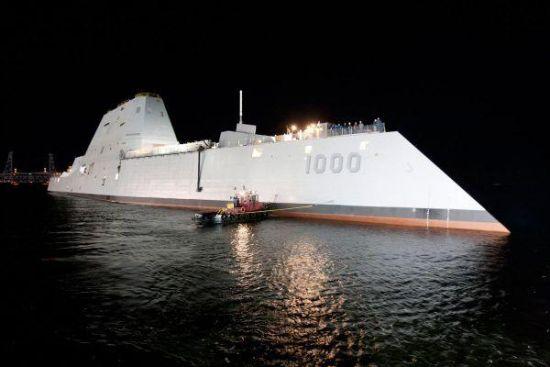

| 送交者: _rainman[品衔R2☆] 于 2015-12-01 10:30 已读 3578 次 | _rainman的个人频道 |
美联社11月29日发表了题为《美国海军新驱逐舰的适航性和稳定性受到质疑》的报道,编译如下:
巴斯钢铁为美国海军建造的最大驱逐舰外观甚是威武。但是,在其威武外表之下的船体类型却是在一个世纪前遭到摈弃的,部分原因是这种船体可能不稳定。
不久之后,当这艘朱姆沃尔特级隐身导弹驱逐舰的首舰12月到波涛汹涌的北大西洋上进行测试的时候,海军就会知道这种“船舷内倾”穿浪舰体的现代版性能如何了。
海军把该型驱逐舰视作奥巴马政府亚太战略中的一个重要组成部分,而对于海军来说,在首舰的成本激增为至少44亿美元而且完工时间一再拖延后,不能再出现任何差错。
一直与造船厂密切合作的缅因州海事博物馆的埃米·伦特说,纳税人无需担心,因为海军和巴斯造船厂“对船体进行了测试”。舰艏向前突出可以乘风破浪。复合甲板室隐藏雷达和天线,使得这艘驱逐舰看起来外观简洁。尖锐的角度有利于对雷达隐形。
然而,“船舷内倾”船体的典型特点是船体边缘在水线以上略向内收拢,这使得“朱姆沃尔特”的形状有点像金字塔。批评人士说,这种形状在某些情况下可能会带来问题。
教授造船学与海洋工程课程的韦布学院院长马修·沃纳说,舰艇设计和建造领域的人士一直对这艘军舰的整体稳定性表示担忧,而如果在战斗中出现损坏,任何不稳定都会变本加厉。
但是,船体两侧的坡度却可以实现海军追求隐形的目标。海军声称,这艘排水量1.5万吨的庞然大物在敌人的雷达上看上去就像一艘小渔船。
沃纳说:“这确实是一个设计上的挑战。他们试图建造一艘具有隐形性能的船只,这对船体形状提出了特定要求。为了做到隐形,他们必须要有所妥协。”
海军历史学家、有时对海军的决定持批评态度的分析人士诺曼·波尔马说,在建造了一个大型模型证明这一概念后,他并不担心“朱姆沃尔特”的适航性。
波尔马说:“如今的技术使得这一概念是可行的,而且更有效率。”
这艘驱逐舰比目前一代驱逐舰大50%,但是有先进的自动化设施可以减少船员人数。它使用与波音777客机上类似的涡轮机发电,带动整艘船只。舰上还有新的雷达和声呐,以及大威力舰炮。
发言人图拉亚·肯特说:“通过大量的电脑模型和模拟,以及在不同海上状况、速度和天气条件下的比例模型测试,海军批准了这艘军舰的设计。我们确信这艘军舰的设计是安全的、适航的,而且其运行参数是清楚无误的。”
现在的目标是明年的某个时候向海军交付使用。 http://www.militarytimes.com/story/military/tech/2015/11/29/hull-aballoo-new-navy-destroyers-seaworthiness-questioned/76527516/Hull-aballoo: New Navy destroyer's seaworthiness questioned
BATH, Maine — The largest destroyer built for the U.S. Navy cuts an imposing figure: massive, with an angular shape, hidden weapons and antennas, and electric-drive propulsion. But underneath the stealthy exterior resides a style of hull that fell out of favor a century ago in part because it can be unstable.
The Navy will soon learn how this modern take on the "tumblehome" hull holds up when the first-in-class Zumwalt heads out to sea in December for builder trials in the rough-and-tumble North Atlantic.
Amy Lent, of the Maine Maritime Museum, which works closely with the shipyard, said taxpayers needn't worry because the Navy and shipbuilder Bath Iron Works have "tested the hell out of it."
"This is an enormous investment. There's so much at stake. They're not slapping something together and sending it out to sea," she said. "I think they're pretty confident. They know what they're doing."
Designers chose the hull style associated with pre-dreadnought battleships, but this warship looks nothing like one from President Theodore Roosevelt's "Great White Fleet."
The inverse bow juts forward to slice through the waves. A composite deckhouse hides radar and antennas, giving it a clean look. Sharp angles deflect radar signals.
Typical of tumblehomes, though, the hull slopes inward above the waterline, giving the Zumwalt something of a pyramid shape. The shape can cause problems in certain conditions, critics say.
Concerns have been voiced in the ship-design and shipbuilding communities about the warship's overall stability — and any instability could be exacerbated if there's battle damage, said Matthew Werner, dean at the Webb Institute, which teaches naval architecture and marine engineering in Glen Cove, New York.
But the hull's sloping sides contribute to the Navy's goal of stealth. The Navy contends the 600-foot-long, 15,000-ton behemoth will look like a small fishing boat on enemy radar.
"It's a true engineering challenge. They're trying to make a ship with stealth characteristics that requires certain shapes. To do that they have to compromise," Werner said.
Norman Polmar, a naval historian, analyst and author who is sometimes critical of the Navy's decisions, said he has no qualms about the Zumwalt's seaworthiness after a large-scale model was built to prove the concept.
The Navy has built a modern version of the tumblehome that utilizes computers to aid in stability, much like the Air Force used computers to transform a flying wing — the B-2 bomber — into a stable aircraft. "The technology today makes that concept doable and much more efficient," Polmar said.
The ship is 50 percent bigger than the current generation of destroyers but has advanced automation to reduce the crew size. It'll use turbines similar to those used in a Boeing 777 to create electricity to drive the ship. It'll have new radar and sonar, and powerful guns with rocket-propelled projectiles.
The Navy, which views the ship as an important part of the Obama administration's Asia-Pacific strategy, can't afford a flop after the cost of the first ship ballooned to at least $4.4 billion and construction fell behind schedule.
"The Navy has validated the ship's design through extensive computer modeling and simulation, as well as scale model testing in various sea states, speeds and weather conditions. We are confident the design is safe, that the ship is seaworthy, and its operating parameters are known and understood," said Capt. Thurraya Kent, a spokeswoman.
Bath Iron Works will be testing the ship's performance and making tweaks this winter. The goal is to deliver it to the Navy sometime next year.
评分完成:已经给本帖加上 20 银元!

